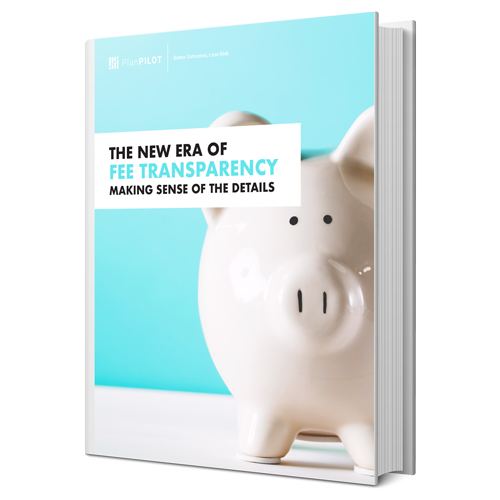According to the Callan Institute, an employee benefits research and investment consultancy group, the issue of high concern for defined contribution plan sponsors is that of retirement plan fees. Specifically noted in Callan’s 2019 Defined Contribution Trends Survey, plan sponsors have identified for the third year in a row that improvements in their fiduciary standing comes from a robust and thorough review of retirement plan fees.
Rising Concern of Retirement Plan Fees
This issue was identified as a top priority for plan sponsors going into 2019 and received the highest survey rating, followed by improving plan participant communications, financial wellness, and investment fund/manager due diligence. Why is the issue of plan fees an important one? According to Investment Company Institute (ICI) data, there was a total of $28.2 trillion in retirement market assets at the end of 2017. Defined contribution plan assets constituted 27.2 percent of this amount ($7.7 trillion), broken down as follows:
- 401(k) plan assets, $5.3 trillion;
- 403(b) plan assets, $1.0 trillion; and,
- $1.4 trillion all other DC plan assets.
The amount of retirement assets held in DC plans represents a huge economic issue that requires scrutiny, as plan fees are the subject of litigation and regulatory concern and focus.
Fees as a Percentage of Retirement Plan Assets
Plan sponsors have a responsibility under the provisions of the Employee Retirement Income Security Act (ERISA) to make their participants fully aware of fees and the investment options available. Fees represent a significant part of the costs that a participant incurs. These include (but are not limited to):
- Fees for the administration of the plan;
- Investment fees paid to the manager(s); and,
- Individual service fees, such as fees that may be assessed when a plan participant takes out a loan.
Fees may be structured as either an asset-based or flat-rate of assets invested in the plan, revenue share from the investment company underlying the plan assets or from the plan’s third-party administrator, or any variation of these. The fees paid can range from basis points (.01% = one basis point) of a plan’s assets upwards to 2.5 percent (and even as high as 4 percent). This amount, over time, reduces the total return a participant receives and also the amount of funds available to them at the point that they choose to retire.
The Importance of Fee Policies
Plan fees are the cost of doing business. Certain costs, such as those for administration and recordkeeping (as required by the U.S. Department of Labor or DOL) are unavoidable. Where concerns are being raised, however, are by those hidden fees that may be hard to uncover or understand for plan participants and sponsors who are not industry insiders. The issue of Callan’s 2019 DC Trends report found that of the plan sponsors surveyed, 19 percent have a written fee payment policy as part of the plan’s investment policy statement and 27 percent of plan sponsors surveyed had the policy statement as a separate document. 10 percent of the plan sponsors had no fee policy statement but intended to have one in place within the next 12 months. That nearly half of the plan sponsors surveyed (46 percent) indicated the existence of a fee statement is indicative of the importance of having one in place, if for no other reason, then to further fulfil a sponsor’s fiduciary responsibility.
The Bottom Line
The DOL is charged with ensuring that a DC plan is compliant with ERISA. A plan sponsor’s responsibilities should drive all toward a better understanding of the fees that are assessed on those plans under the sponsor’s fiduciary control. This begins with a thorough review of the plan, if not on a semi-annual then annual basis, to see if the investment and administrative fees charged are in line with what is fair and appropriate.
Sponsors must demand greater fee transparency. If a fee can’t be properly disclosed and described by the provider, it may not be a fee that is necessary. Conflicts of interest should be avoided (as required by DOL under ERISA) and revenue sharing arrangements reduced that drive up the investment costs of a plan and drive down investment performance for the participants.
An investment fee policy should be reviewed (or created) and made a part of the plan documents. This document should require transparency, disclosure, and communication of any and all fees that a participant pays and how they are paying them. Taking the time to investigate these costs as part of a sponsor’s routine due diligence may be what is required to keep plan fees in check.
Get Expert Help
Those who are uncertain as to how best to proceed should consider contacting an independent Registered Investment Advisor, such as PlanPILOT for help. We can help you review, understand and document the various levels of fees for your plan. Plan sponsors also rely on us to review fund lineups and provide scorecards of investments, highlighting any changes recommended. Contact us today at (312) 973-4911 or email info@planpilot.com.
|
The New Era of Fee Transparency An important fiduciary responsibility is to understand the services being provided and ensure that the fees being charged to the plan are reasonable. |
Related Posts
 Why Plan Sponsors Should Hire a Retirement Plan Consultant - Learn why plan sponsors choose to work with a retirement plan consultant, as well as a few of the questions you'll want to ask if… ...Read More
Why Plan Sponsors Should Hire a Retirement Plan Consultant - Learn why plan sponsors choose to work with a retirement plan consultant, as well as a few of the questions you'll want to ask if… ...Read More Evaluating Your Plan’s Recordkeeper - Learn more about the role a plan recordkeeper plays and some of the factors plan sponsors should consider when choosing and evaluating a recordkeeper. ...Read More
Evaluating Your Plan’s Recordkeeper - Learn more about the role a plan recordkeeper plays and some of the factors plan sponsors should consider when choosing and evaluating a recordkeeper. ...Read More Benefits of an OCIO Search Consultant - There are many reasons it can make sense to outsource your chief investment officer (CIO) functions and duties, but finding the right OCIO manager is… ...Read More
Benefits of an OCIO Search Consultant - There are many reasons it can make sense to outsource your chief investment officer (CIO) functions and duties, but finding the right OCIO manager is… ...Read More

